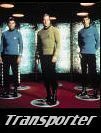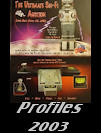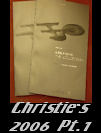Saturday, January 31, 2009
Star Trek: Voyager Compression Phaser Rifle
This design of Starfleet phaser rifle weapon, also known as a type-3 phaser, was first seen in the series premiere episode of Star Trek: Voyager entitled "Caretaker" (1995). The screen-used prop photographed below is constructed largely of solid resin pieces, with softer plastic end-pieces, and features a miniature flashlight built-in to the top sight mechanism as its only "working" component.

Monday, January 26, 2009
TOS Special Effects: Silver Eyes
Herb Solow, Desilu's executive in charge of production for Star Trek and Robert Justman, Co-producer of TOS, presented an amusing anecdote in their book "Inside Star Trek: The Real Story" (Pocket Books, 1996) that reveals the history behind an important special effect required for the 2nd pilot of Star Trek "Where No Man Has Gone Before" -- the first TOS episode to feature William Shatner as Captain Kirk and the pilot that won network approval for production of the historic television series. The story is presented as follows ...
Magic time was closing in on Justman again. Of his remaining preproduction duties, one of the most important was to obtain “silver eyes” for Sally Kellerman and Gary Lockwood. The script called for their characters to mutate into all-powerful godlike creatures, the outward signs of which would be their normal eyes transformed into shiny, silver-colored orbs.
Justman phoned around only to find that a few optical houses still made old-fashioned “scleral” lenses that covered the entire eyeball, but not one of them wanted to undertake the difficult and possibly lawsuit-provoking task. One firm gave him the name of the Roberts Optical Company, stating, “If John Roberts can’t make them, no one can!”
BOB: “Silver eyes?” John Roberts was incredulous.
Over the phone, it sounded bad, the way the optician said it. But I persisted. “Yes, Mister Roberts. My name is Bob Justman. I’m from Desilu Studios. We’re making a new science-fiction television show and two of the stars have to have silver eyes.”
“Silver eyes,” he repeated. He sounded gruff.
“Yes. We need silver eyes. The people at Security Contact Lens recommended you. They said if anyone could make them, you could.”
“They did, did they?” He sounded skeptical. Less gruff but skeptical.
“Yes, they said something about ‘schollario’ lenses –“
“Scleral,” he interrupted. “Not like what we use today. Scleral lenses cover the whole eyeball. You sure that’s what you want?”
“Yes, that’s exactly what we want.”
“Nobody else does. They’re too damned uncomfortable. Who’s going to wear them?”
“Sally Kellerman and Gary Lockwood. They’re …”
“Never heard of them.”
“Well, they’re both pretty well known and …”
“How you get them to look like silver, that’s the problem.”
“Gary had his own series, The Lieutenant, and …”
“You could maybe coat the outside with silver enamel, you know, paint it on.”
“You could? That’s great!”
“But it wouldn’t work.”
“Oh …”
“What you’d have to do is laminate something inside the lens. That would make it double-thick, but it could work.”
“Great!”
“Naw. They’d be too damned uncomfortable. Maybe even dangerous if you had ‘em in too long.”
“Oh …”
“It’s a challenge. I’ve never done anything like that. Come on by my office on Monday at nine and take a look. I’ll dream something up over the weekend.”
“Gee, thanks …” He’d already hung up.
When I arrived at John Roberts’s Beverly Hills office at nine on Monday, he had a sample pair of silver eyes waiting. “Stayed up the whole damn weekend, working on this,” he grumbled. “I had to crumple up tinfoil and laminate it between the two outer layers. See?”
“Yes, they’re real silver-looking, all right. Tell me, how are the actors going to see through them?”
“See through them? You didn’t say anything about seeing through them.”
“Oh. Well …”
“It wouldn’t take much, though. Just a small hole in the tinfoil. You’d never notice it unless you looked for it. Come back Wednesday.”
I did. And he had silver contact lenses that could be seen through. “Great work, John.” By this time, we were on a first-name basis. But now came the tough part. “You said they might be dangerous.”
“Damn right. You wear things this thick for any length of time, heat builds up in the eyeballs behind the lenses and it gets damn uncomfortable—painful, in fact.”
I couldn’t in all good conscience ask the actors to wear the lenses if I couldn’t. So I tried them on. As John had said, they were damn uncomfortable. But they could be worn. And I could see with them on, not well enough to navigate. And John assured me that if the actors wore them for only short periods of time, they’d be safe.
Eureka! We had our silver eyes!
I arranged appointments for Sally Kellerman and Gary Lockwood to be fitted for the lenses by John Roberts. Sally’s fittings went fine. She was in and out in no time at all. Before delivering the custom-made lenses to her, I tried them on. After a minute or two, they drove me nuts, but Sally could pop the lenses in and out at any time, without difficulty, and wear them without any pain. Even the buildup of heat between the lenses and her eyeballs didn’t faze her.
But Gary Lockwood was a whole ‘nother story. His fitting took a long time. Later, on stage, after much fussing , he’d finally manage to get the lenses in between his eyelids and his eyeballs. But he could hardly see while wearing them. In order to have any vision at all, Gary had to raise his chin and look down his nose at the other actor in the shot. Happily, this gave him an unearthly appearance that worked well for his character and even helped his godlike progression.
Below are some screenshots that reveal the end result of John Roberts's handiwork ...


Sunday, January 25, 2009
TOS Special Effects: Sliding Doors
While automatic sliding doors are commonplace in today’s shopping malls and supermarkets; this was not the situation when Star Trek: The Original Series first aired on network television – as audiences witnessed the technology aboard the Enterprise respond incredibly quickly and smoothly in anticipation of the crews movements. Herb Solow, Desilu’s Executive In Charge of Production for Star Trek, discusses this aspect of TOS special effects in “Inside Star Trek: The Real Story” (Pocket Books, 1996) …
Superior hand-eye coordination was necessary for brain surgeons, prestidigitators, and the guy responsible for opening the various doors on the set. He accomplished it by standing out of sight of the camera and running the “mechanisms.” The mechanisms consisted of wires attached to the sides of the doors and threaded through a series of pulleys. The assistant director, standing behind camera and watching the scene, would trigger a red light that cued the offstage guy that the moment had arrived for him to open the doors. He would yank on the main wire. This activated the wires running through the pulleys and opened the doors just in time for Kirk or Spock to enter or exit.
The mechanisms always worked; the people responsible weren’t as dependable. Sometimes the cue would be given too early, and the doors would open long before the actors reached them. This “magic door” syndrome usually brought an enthusiastic laugh from everyone except, perhaps, the director, who was usually behind schedule. To him, it wasn’t funny.
Sometimes the cue would be given too late and the actors, trusting souls that they sometimes were, bounced off the unopened doors. This almost always brought an enthusiastic laugh, especially from the director. De Kelley was overheard to remark, “You can get killed walking to the coffee shop aboard this ultra-modern space cruiser.”
Later, when a builder in Santa Barbara, California, wrote to us asking for ideas on how to build sliding doors that work as quickly as those aboard the Enterprise, my recommendation to Bob was to tell the builder to get a different assistant director and a faster offstage guy.
















































































































































